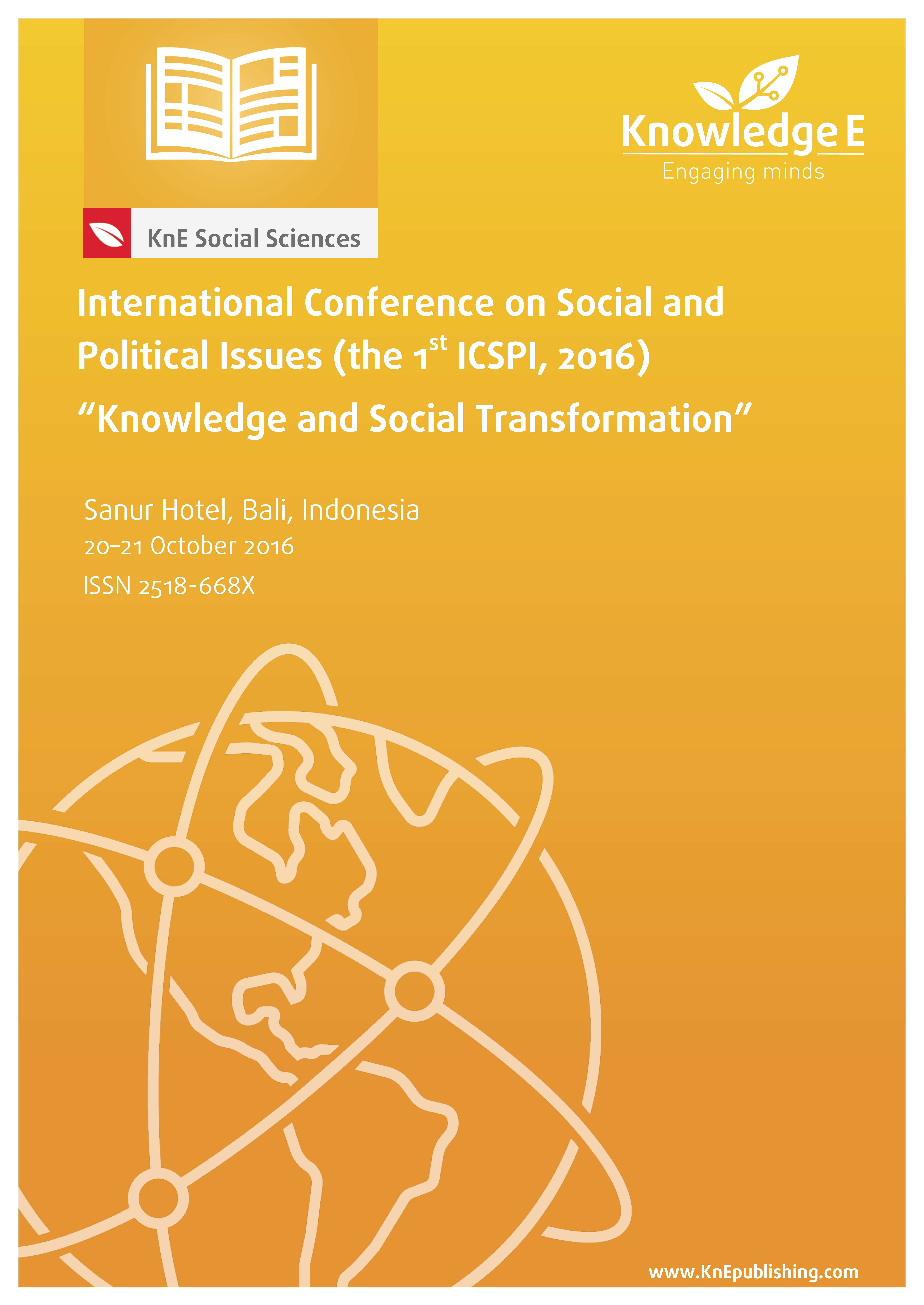Global Brand Perception in Indonesian Young Consumer
DOI:
https://doi.org/10.18502/kss.v3i10.2921Abstract
Global brands have been dominating Indonesian market in these few last years. Indonesia itself is one of a unique and heterogeneous market which is supposed to be difficult to penetrate but the reality shows that Indonesian market has tendency to accept foreign products easily. In addition, Indonesian consumers were very open minded with global brand that was made these brands strong and dominated more than 50% Indonesian market. The global marketers demonstrate their strategic plan to integrate their messages and build good perception in Indonesia notwithstanding the variety of target consumers’ characteristic. Perception itself is an important phase to create the next level of consumer behaviour, which is purchase and repurchase. This research tried to define the integrated marketing communication (IMC) strategy in developing perception in Indonesia and measure its effectivity on develop perception. From various strategy inside IMC, the research will try to quantify which one is more effective than others and also measure its possibility to adopt the strategy for another product, especially the local brand. Besides that, this research also measured the relation between demography and income to perception of global brand. Magnum Indonesia has been chosen based on their success in Indonesia ice cream market and change people’s opinion about ice cream, from a product for kids into a lifestyle brand. The survey used as a tool in this research and focused on Generation Y as the biggest target market in the world right now and to dig more about their understanding and motivation to choose global brand than the local one. This research chooses Yogyakarta and Jakarta as the target cities which represents the divergence of respondents’ characteristic.
Keywords: integrated marketing communication, perception, generation Y, consumer behaviour, global brand
References
Alden, D., Steenkamp, J.B. and Batra, R. 1999. Brand positioning through advertising in Asia, North America, and Europe: The role of global consumer culture. Journal of Marketing, 63, 75-87.
Babbie, E. 2013. The Practice of Social Research (13th eds.). Belmont, USA: Wadsworth.
Belch, G.E. & Belch, M.A. 2003. Advertising and Promotion: An Integrated Marketing Communication Perspective (6
Bovee, Courtland L. & Arens, William F. 1986. Contemporary Advertising.Illinois: Irwin Homewood.
Brand Asing Kuasai Pasar Indonesia. 2013. Harian Neraca. Retrieved from http:// www.neraca.co.id/harian/article/28575/Brand.Asing.Kuasai.Pasar.Indonesia.
Bray, J. P., 2008. Consumer Behaviour Theory: Approaches and Models. Retrieved from http://eprints.bournemouth.ac.uk/10107/
Chan, K. (2008) Chinese children’s perceptions of advertising and brands: An urban rural comparison, Journal of Consumer Marketing, 25(2), 74-84.
Dogerlioglu-Demir, K. and Tansuhaj, P. 2011. Global vs local brand perceptions among Thais and Turks. Asia Pacific Journal of Marketing and Logistics, 23(5), 667- 683. DOI 10.1108/13555851111183084.
Eastman, J.K. and Eastman, K.L. 2011. Perception of status consumption and the economy. Journal of Business & Economics Research, 9(7), 9-20.
Finne, A. and Gronroos, C. 2009. Rethinking marketing communication: From integrated marketing communication to relationship communication. Journal of Marketing Communications, 15 (2-3), 179-195.
Gabrielli, V. and Balboni, B. 2010. SME practice towards integrated marketing communications. Marketing Intelligence and Planning, 28(3), 275-290. DOI 10.1108/02634501011041426.
Heding, T., Knudtzen, C.F. and Bjerre, M. 2009. Brand Management: Research, Theory and Practice. New York: Routledge.
Hybels, S. and Weaver, R.L. II. 2004. Self, perception, and communication. In Communication Effectively (7th ed.). Boston: McGraw-Hill. Retrieved fromhttp:// highered.mcgrawhill.com/sites/dl/free/0072563974/87088/Hybels_02.pdf
Ing, W.P., Phing, G.T.T., Peng, N.C., Ho, J.S.Y. and Teik, D.O.L. 2012. Global versus local brand: perceived quality and status-seeking motivation in the automobile industry. World Review of Business Research, 2(4), 1-12.
Kitchen, P.J., Brignell, J., Li, T. and Jones, G.S. 2004. The Emergence of IMC: A Theoretical Perspective, Journal of Advertising Research,19-30.
Krismiyati and Wijaya, L.S. 2013. Identifying marketing public relation strategies implemented in private universities for increasing students’ intake in Central Java Indonesia. International Refereed Research Journal, 4(2), 43-49.
Kumara, S. and Ashan, M.J.F, 2004. Influence of demographic variables on the perceptions of country of origin as a quality attribute of milk powder P.A.P. Retrieved from http://www.ruh.ac.lk/research/academic_sessions/2004_ mergepdf/155-164.PDF
McCrindle, M. and Wolfinger, E. 2010. Generations defined. Ethos, 18(1).
McLuhan, M. and Fiore, Q. 1967.The Medium is the Message: An Inventory of Effects. New York: Bantam.
Miller, K. 2002. Communication Theories: Perspectives, Processes and Contexts. Boston: McGraw-Hill.
Milner, D. 1995. Success in Advertising and Promotion. London: John Murray Ltd.
Moriarty, S., Mitchell, N. and Wells, W. 2012. Advertising and IMC: Principles and Practice (9th ed.). New Jersey: Prentice Hall.
Priyatno, D. 2012.Cara Kilat Belajar Analisis Data dengan SPSS 20. Yogyakarta: Penerbit Andi.
Robertson, R. 1992. Globalization: Social Theory and Global Culture. London: Sage.
Satawedin, P. 2005. Marketing public relations (MPR): The unbelievable integrated marketing communication. Bangkok University International College Academic Review, 4 (2).
Subramaniam, S. Mohre, R. and Kawde, D. 2014. Customers’ perception: towards brand. SCMS Journal of Indian Management, 93-101.
Sue, V.M and Ritter, L.A. 2012. Conducting Online Surveys. Thousand Oaks, California: Sage Publication.
Sun, M.W. 2011. Consumption of luxury fashion brands: the motives of generation Y consumers in China (Master thesis). Retrieved from http://aut.researchgateway.ac. nz/bitstream/handle/10292/1335/SunM.pdf?sequence=3.
Tsikirayi, C.M., Muchenje, B. and Katsidzira, Z. 2013. Impact of integrated marketing communications mix (IMCM) in small to medium enterprises (SMEs) in Zimbabwe as a marketing tool. Research in Business and Economics Journal, 7(8), 167.
Vadim, K.D. 2011. Income as a Factor of Consumer Behaviour of Latvian Inhabitants in Economics and Tourism. Retrieved from: http://www.culturaldiplomacy.org/academy/content/pdf/participantpapers/2011/april/b ec-roa-Nua/income_as_ a_factor_of_consumer_behaviour_of_latvian_inhabitants_in_economics_and_ tourism-_krasko_d._vadim.pdf
Uyanto, S. 2006. Pedoman Analisis Data dengan SPSS. Yogyakarta: Graha Ilmu.

